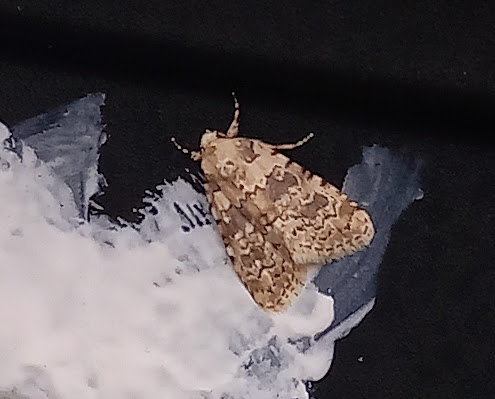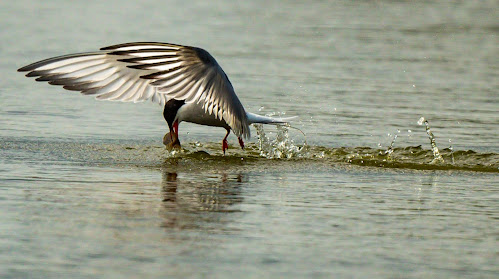Thursday 22nd June 2023.
Only my second ever Marbled Yellow-pearl seen. This is an uncommon immigrant moth and I am well pleased it ended up in my garden. I shall release it tonight from its pot once it's dark.
I couldn't resist another moth session this morning at 4.30am (I need locking up & possibly therapy!!!) and so I put the moth box on and again last night and was rewarded with some decent moths that were added to my ever growing year list. It was overcast first thing this morning with a light breeze and judging by the white sheet and the surrounding area, it certainly looked promising.
Above, my first Clancy's Rustic of the year and below, the micro moth Dingy Dowd (Blastobasis adustella), another new moth for the year. The latter I see throughout the summer months.

Promising it was, with yet another rare moth in the bag as I found an immigrant moth resting on top of the box lid. It was a Marbled Yellow-pearl (Evergestis extimalis) and although they do breed in the UK in small numbers, it is considered to be an uncommon migrant here in the south. This was my second ever of this species. There were another three moth species that were new for the year and included a pristine Clancy’s Rustic. This species is now starting to be regular here in my garden (three years running), though by no means common either. Two relatively common macro moths made their annual debut today: Clepsis consimilana and Blastobasis adustella; both of which are abundant during the summer months. There was also my first Snout moth of the year for my garden (actually, it was inside my kitchen to be honest!) after one seen in Andy Fisher’s garden earlier this month. I have started to use the venicular names for a lot of the micros now, which should help those starting to learn moths and not totally refer to their scientific name.

Above, my first Privet Tortrix (Clepsis consimilana) of the year and below, the Yellow Oak Button (Aleimma loeflingiana), which is now turning up regularly this week.
Other notable moths included my second Buff-tip and Gold Triangle of the year. In total, there were 101 moths of 38 species. Away from moths, a family friend, Penny Townsend, had her regular Badgers outside her Gosport home again (see photo). I must try and get over there to see them for myself. Fellow 'Lazee Birder' Andrew Dickety sent me over several moths to ID from his Sister's house on the Isle of Wight. Glad to oblige.
The only Large Yellow Underwing in my moth box this morning. This species has gone relatively quiet again, but I liked this photo as it shows the bright underwing for a change. Mind you, why this species is called 'Yellow' instead of Orange, heaven knows! I think the chap who ID'd it must have been colour blind!
Moths present this morning included the following:
- 10 Willow Beauty
- 7 Pale Mottled Willow
- 1 Brimstone Moth
- 1 Common Emerald
- 4 Bright-line Brown-eye
- 1 Dark Arches
- 7 Lime-speck Pug
- 2 Common Pug
- 2 Double-striped Pug
- 1 Snout
- 1 Shuttle-shaped Dart
- 1 L-album Wainscot
- 2 Garden Carpet
- 1 Large Yellow Underwing
- 7 Riband Wave
- 2 White Ermine
- 1 Buff Ermine
- 5 Heart & Dart
- 1 Buff-tip
- 1 Marbled Minor
- 2 Small Dusty Wave
- 1 Clancy’s Rustic (NFY)
- 1 Marbled Yellow-pearl (NFY)
- 2 Apple Leaf Miner
- 2 Clepsis consimilana (NFY)
- 5 Diamond-back Moth
- 1 Celypha striana
- 9 Garden Grass-veneer
- 1 Blastobasis adustella (NFY)
- 1 Psychoides filicivora
- 6 Common Plume
- 2 Ephestia woodiella
- 1 Tachystola acroxantha
- 3 Zeiraphera isertana
- 1 Gold Triangle
- 1 Mompha subbistrigella
- 1 Bee Moth
- 2 Box Tree Moth
- 2 Aleimma loeflingiana
A superb photo of one of Penny Townsend's Gosport Badgers last night.
This evening, some more moths were found around the house that included a Beautiful Plume, a Double-striped Pug and the Snout was still present near the back door to the garden. Another Dingy Dowd was identified by a kind chap on the UK Micro Moth Identification site to add to my day total. Last night, I had two Bats flying over our gardens, which I can only assume are Pipistrelle’s.
This Saturday, I am off to Durlston Head again for our annual pilgrimage to see the Puffins. John Goodall rang me tonight to arrange Saturday morning and he told me that he saw an Osprey flying north over Waterlooville today from his garden. Just goes to show that even in the height of summer, anything can turn up!
I would like to round off the day with this superb photo of a Common Tern catching a fish off Pennington Marshes. Simply stunning. Photo by Ollie Crabbe.

















































